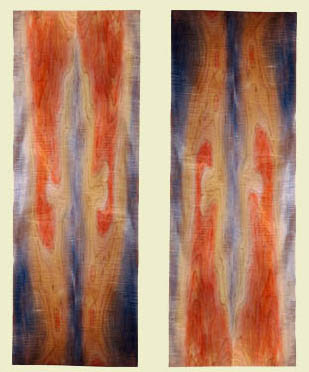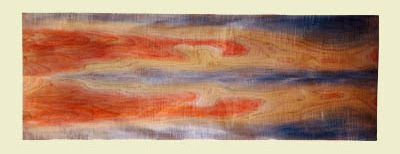
Untitled (2008)
-- I had planned to hang it in the orientation on the right the entire time I was working on it. However, when I was done and hung it, I decided I liked it better in the orientation on the left. What makes one orientation of an abstract painting better than another? I think part of the issue is that, even though it is abstract, it is not so abstract that our minds can't create a figure or image within it. Our minds want to make sense of a piece, and the orientation that is more figurative, or at least implies a more pleasing figure, is the preferred one. With the piece above, the image on the right makes me think of aliens being beamed up to their space ship, or lobster claws; but the image on the left makes me think of a blue animal (a bird?) reaching for the sky, or the back of someones legs. When making the piece, I guess I must have thought that aliens being beamed up was interesting, but when I was finished, and saw them being beamed up, I found it disturbing. Luckily, there was something in the 180 orientation provided an alternative to the aliens.Then, to my surprise, when the couple asked about purchasing it, they wanted to know if it could be hung horizontally. It had never crossed my mind to hang it horizontally so I was surprised to find that it works in that direction as well, becoming a landscape and implying a reflection on water. I can see now why someone would want it in this direction. I think it is even more abstract and peaceful horizontally.
 I've been torn by how I feel about the orientation of a piece. On one level I think, as an artist, that I should care about the direction my work is hung; that I should decide what a piece is and how it should be viewed. But the reality is, and I have come to accept, that I really don't care. All I can and should do is find the orientation that I think it shows best in, and then leave it to the buyers to view it in the way that gives them the most pleasure. If a piece is abstract, then it is abstract and open for interpretation. There is nothing final about my interpretation and, in fact I might find that in six months I like it in another direction, as I did with the two piece below. Although they both work either horizontally or vertically, it took me six months to realize that viewing the figure in the wood was much more dynamic in the horizontal orientation. The figure is so intense, that you can see the piece change dramatically as you move across a room.
I've been torn by how I feel about the orientation of a piece. On one level I think, as an artist, that I should care about the direction my work is hung; that I should decide what a piece is and how it should be viewed. But the reality is, and I have come to accept, that I really don't care. All I can and should do is find the orientation that I think it shows best in, and then leave it to the buyers to view it in the way that gives them the most pleasure. If a piece is abstract, then it is abstract and open for interpretation. There is nothing final about my interpretation and, in fact I might find that in six months I like it in another direction, as I did with the two piece below. Although they both work either horizontally or vertically, it took me six months to realize that viewing the figure in the wood was much more dynamic in the horizontal orientation. The figure is so intense, that you can see the piece change dramatically as you move across a room.






Geez, it's been too long since I've read your blog, Rob. Much water under the bridge. In the first piece I see the second iteration (on the left) as arms reaching down from above. Like God maybe (just kidding...).
ReplyDeleteAnd with respect to the whole issue of orientation, one of the coolest exhibits I ever saw was a show of maps at the Cooper-Hewitt in NYC. One of the maps was from Australia, and showed the southern hemisphere on the top and the northern hemisphere on the bottom. Jangled the mind, but really the point was that the planet is floating in space and there IS no up or down. What's good enough for the universe is good enough for art, I'd say, as you have discovered! (And then, of course, there's Georg Baselitz!)
Thanks for the reference to Georg Baselitz. I hadn't heard of him though I should know his work. Thanks to the internet, I now do, and I even understand your reference, that he hangs figurative work upside-down, like the one here: http://www.ncartmuseum.org/collections/highlights/20thcentury/20th/1950-2000/baselitz_lrg.shtml.
ReplyDelete